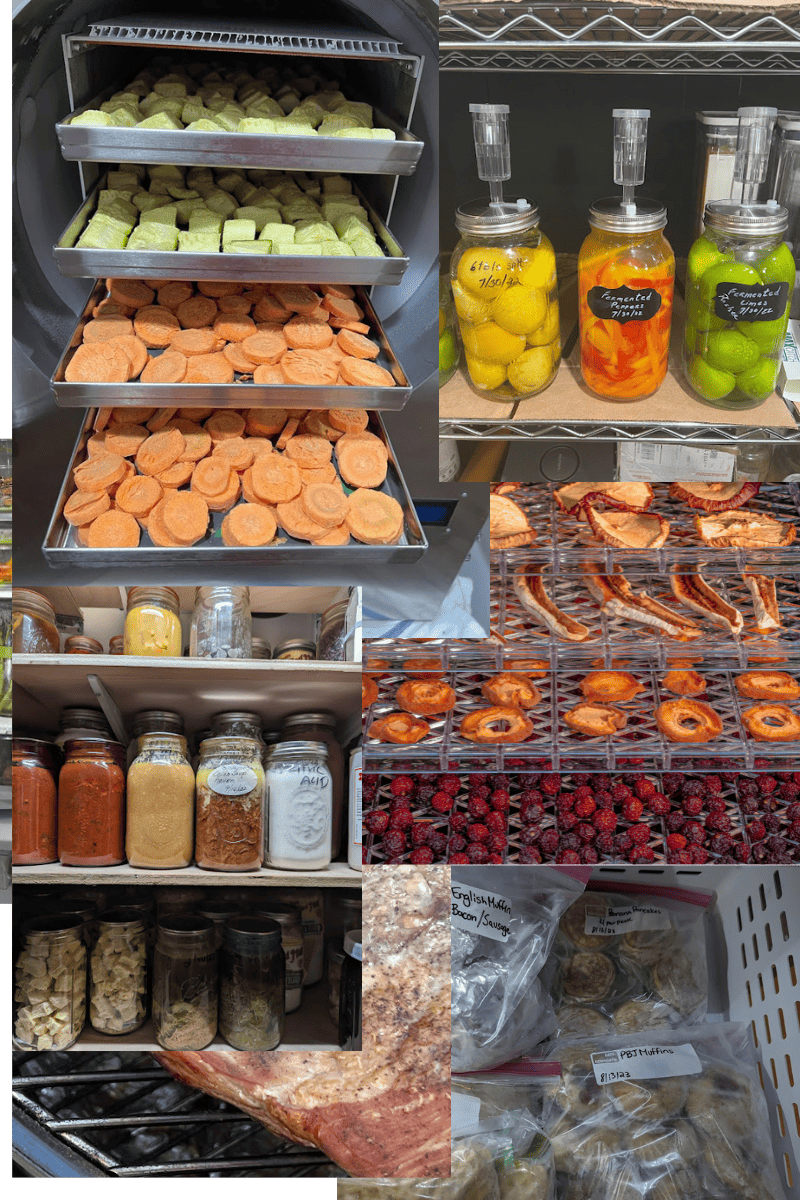When it comes to preserving your food, not all methods are created equal. The goal is to keep your food as nutritious and delicious as possible. That’s where freeze drying stands out. While other preservation methods, like canning or dehydrating, are effective in making foods longer-lasting or shelf-stable, they can sometimes come at the cost of the nutrients in your food. Let’s explore how freeze drying stacks up against these traditional methods and why it’s a top choice for keeping your food healthy.
The Freeze Drying Nutrient Advantage
Freeze drying is known for its ability to retain the nutritional content of your food. When you freeze dry healthy food, the process involves freezing the food first and then removing the water content through a vacuum process. This method preserves nearly all the vitamins, minerals, and antioxidants that make your food nutritious. Unlike other methods that use heat, freeze drying keeps the food’s cellular structure intact, so the nutrients stay where they belong—right in your food.
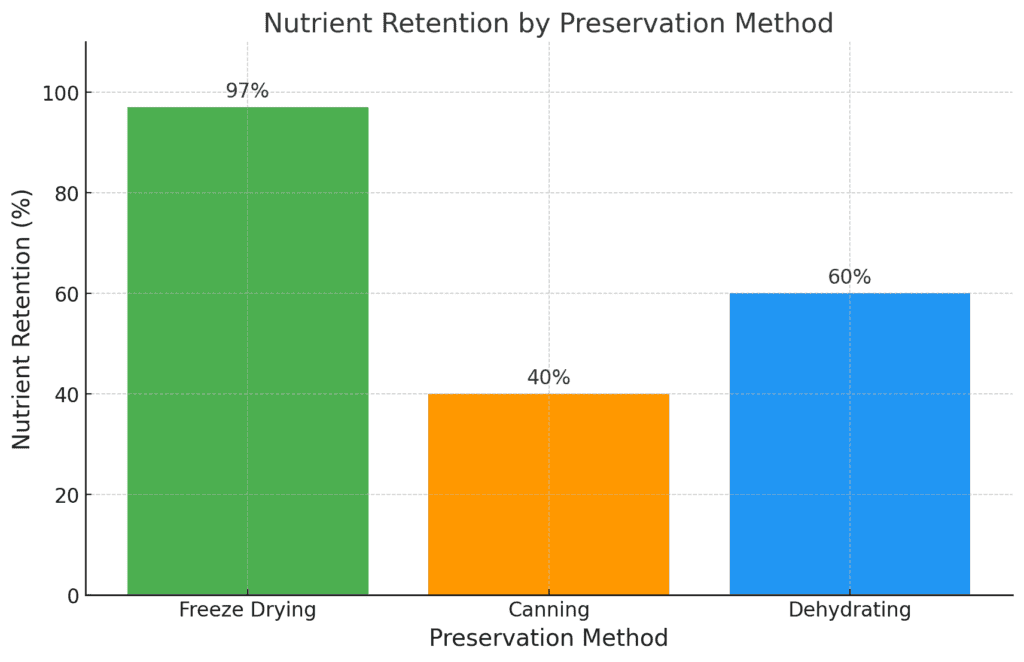
Dehydrating vs. Freeze Drying
Dehydrating is another popular method for preserving food, but how does it compare when it comes to nutrient retention? Dehydrating involves using heat to remove moisture from food, which can lead to the loss of some nutrients. While it’s a great method for making snacks like dried fruits or jerky, the heat can reduce the content of vitamins like A and C.
When you freeze dry healthy food, on the other hand, the low temperatures used in the process help preserve these vitamins. The result? You get a final product that’s closer in nutritional value to the original fresh food.
Canning vs. Freeze Drying
Canning has been a go-to method for food preservation for generations due to its convenience of use, but it comes with its downsides. The canning process requires high temperatures to kill bacteria and seal the food in airtight containers. While this makes the food shelf-stable for a long time, it also means that some of the food’s nutrients are lost in the process. Heat-sensitive vitamins, particularly vitamin C and certain B vitamins, are often the first to go.
In contrast, freeze drying operates at much lower temperatures, which helps retain more of these valuable nutrients. Additionally, freeze dried foods don’t require the added sugars or salts that are often used in canning to enhance appearance, flavor or preserve texture. This makes freeze dried foods a healthier option, especially for those looking to reduce their intake of processed ingredients.
Long-Term Nutrient Retention
Another factor to consider is how well nutrients are retained over time. Both canned and dehydrated foods not only loose nutrients during the initial preservation, they can also lose even more nutrients during storage, especially if they’re not kept in ideal conditions. Exposure to light, heat, and air can further degrade the nutritional content. On the other hand, freeze dried foods are incredibly stable when stored properly. As long as they’re kept in airtight containers away from moisture and light, they can retain their nutrients for years.
Freeze drying can help maintain a well-stocked pantry of nutritious foods. Whether you’re prepping for emergencies, storing seasonal produce, or just making sure you have healthy snacks on hand, freeze drying ensures that your food stays as nutritious as the day you preserved it.
Why Freeze Drying is the Best Choice for Healthy Food
When comparing nutrient retention across different preservation methods, freeze drying clearly comes out on top. Freeze drying locks in those nutrients, ensuring that what you put into the freeze dryer is what you get out. This makes freeze drying the only choice for people who want to maximize the nutritional value of their food. It preserves the vitamins, minerals, and antioxidants in your food, ensuring that you’re getting the most out of what you eat. Whether you’re looking to preserve fruits, vegetables, meats, dairy or full meals, freeze drying offers the best balance of convenience and nutrition.
Ease of Use and Convenience
When it comes to preserving your food, convenience is key. You want a method that’s not only effective but also easy to use, especially if you’re busy juggling work, family, and a healthy lifestyle. While there are several ways to preserve food, freeze drying stands out for its ease of use and the level of convenience it offers.
Set It and Forget It
One of the biggest advantages of freeze drying is its “set it and forget it” nature. Once you’ve prepped your food and placed it in the freeze dryer, the machine does all the work for you. There’s no need to monitor the process constantly or worry about timing things perfectly. You can go about your day, whether that means heading to work, running various errands, hitting the gym, or spending time with your family, knowing that your food is being preserved with minimal effort on your part.
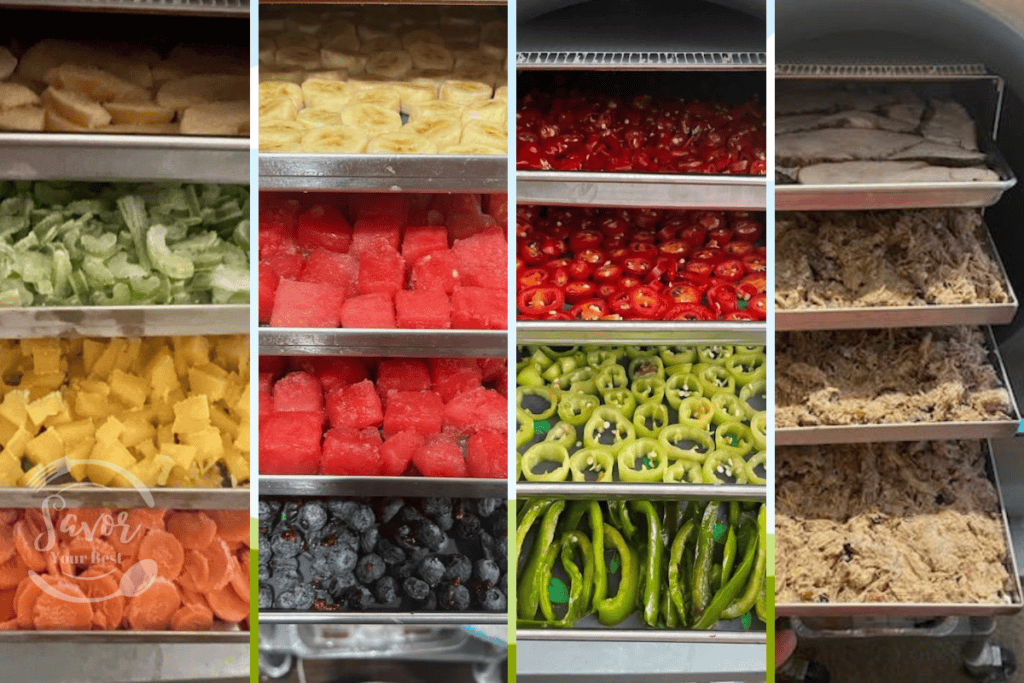
Compare this to canning, where you need to be involved in every step—from sterilizing jars to ensuring that they seal properly. Canning can be time-consuming and requires a lot of attention to detail. Similarly, dehydrating, while less labor-intensive than canning, still requires you to rotate trays and monitor the process to ensure even drying. With freeze drying, you simply load the trays, press a button, and let the machine do its magic. This level of hands-off convenience is perfect for those who want to freeze dry healthy food without spending hours in the kitchen.
Versatility in What You Can Freeze Dry
Another point in favor of freeze drying is its versatility. You can freeze dry almost anything—fruits, vegetables, meats, dairy, and even complete meals. Whether you want to preserve your garden’s harvest, prepare meals for a busy week, or create healthy snacks for your family, freeze drying has you covered. The ability to preserve both raw and cooked foods means you can customize your freeze drying process to fit your needs.
Dehydrating, on the other hand, is limited in what it can handle. While it’s great for fruits, vegetables, and some meats, it doesn’t work well for dairy or complete meals. Canning is versatile, but it requires different processes for different types of food, which can complicate things. With freeze drying, you don’t need to worry about switching between methods or dealing with complex procedures. It’s a one-stop solution for preserving a wide variety of foods, making it incredibly convenient.
Long-Term Storage Made Easy
When it comes to storing preserved food, freeze drying again proves to be a convenient choice. Freeze dried foods are lightweight, compact, and have a long shelf life. Once you’ve freeze dried your food, storing it is as simple as sealing it in Mylar bags or airtight containers with oxygen absorbers. These lightweight packages are easy to store, whether in your pantry, basement, or even a small apartment.
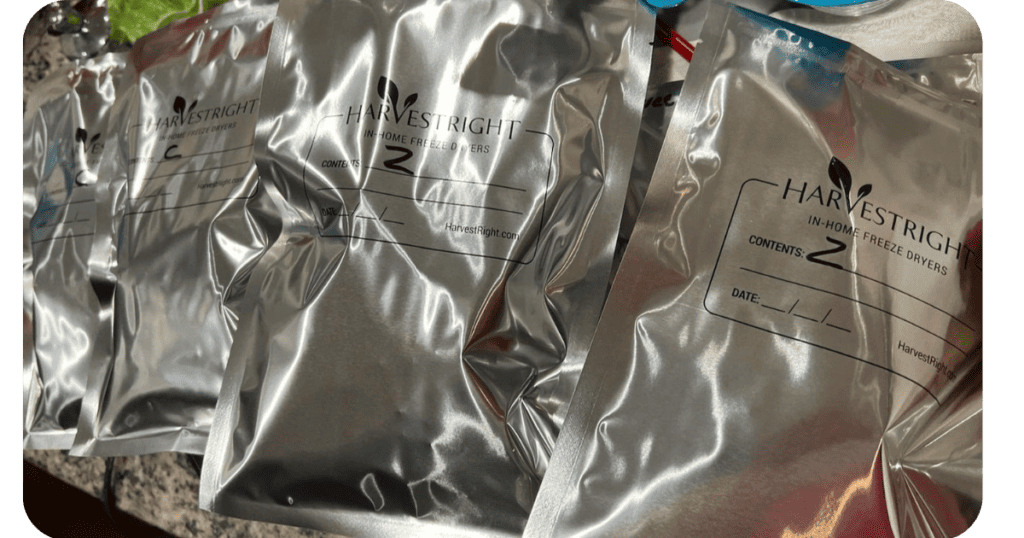
Canned goods, by comparison, are bulky and heavy, taking up a lot of space in your pantry. They’re also more prone to damage—one dropped jar could result in a big mess. Dehydrated foods are lighter than canned goods but often still require special storage conditions to keep them from reabsorbing moisture. With freeze dried food, you don’t need to worry about these issues. The process removes nearly all moisture, so your food remains stable and safe to eat for years, with minimal storage requirements.
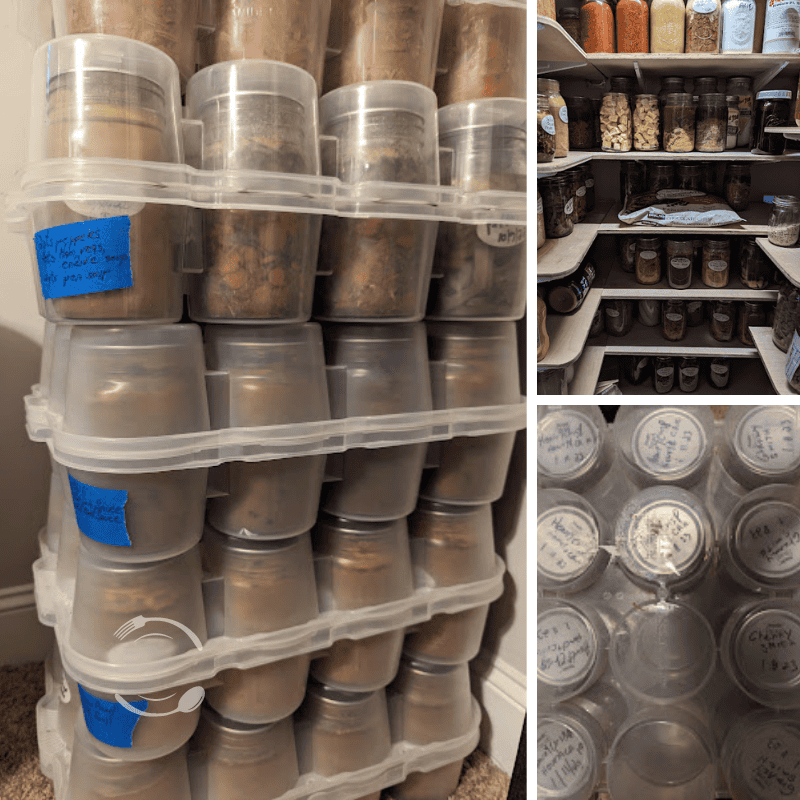
Easy Rehydration and Meal Prep
One of the often-overlooked conveniences of freeze drying is how easy it is to prepare a meal once the food is preserved. Many freeze dried foods can be eaten without rehydration. But when you do want to rehydrate your freeze dried foods, they quickly return to their original texture and flavor with just a bit of water. This means you can have a healthy, home-cooked meal ready in minutes, whether you’re at home, camping, or on the go.
Dehydrated foods are not often meant to be rehydrated. But if you tried, it would take longer to rehydrate and may not always have the best texture, particularly for vegetables and meats. Canned foods, while ready to eat, often require additional preparation to make a complete meal, and they might not taste as fresh as you’d like. Freeze dried foods require a short time to rehydrate and then can be prepared as fresh ingredients would be, making meal prep quick and easy. Also, many times freeze dried ingredients can be added into recipes without first rehydrating, letting the wet ingredients take care of the rehydration. This offen melds flavors together more intensely and deepens the flavor profile, effects that would normally take more sophisticated and time consuming cooking techniques to achieve.
Minimal Maintenance and Effort
Maintenance requirements can add a lot of time and money to each preservation method. Freeze dryers are designed to be user-friendly, with easy-to-clean trays and simple maintenance procedures. After each use, you just need to clean the trays and occasionally change the oil in the vacuum pump, depending on the model. It’s a small effort compared to the long-term benefits you get from preserving your food.
Canning requires a lot more cleanup—sterilizing jars, cleaning up spills, and dealing with sticky messes. Dehydrators, while less messy, often require you to rotate trays and clean multiple surfaces to prevent food from sticking. Freeze drying keeps things simple. With just a few minutes of cleanup, you’re ready to start your next batch.
Impact on Food Flavor and Texture
When it comes to preserving food, flavor and texture are everything. You want your food to taste just as good as the day you prepared it, and you don’t want to compromise on that satisfying bite. Whether you’re freeze drying fruits, vegetables, or full meals, maintaining the original flavor and texture is key. But how does freeze drying stack up against other methods like canning and dehydrating?
Freeze Drying: Locking in Freshness
One of the standout benefits of freeze drying is how well it preserves the natural flavor of your food. The freeze drying process involves freezing the food and then removing the moisture through sublimation. This method is gentle on the food’s structure, meaning the flavors stay locked in without being altered. When you rehydrate freeze dried food, it tastes almost identical to how it did before being preserved. This makes it an excellent option if you want to freeze dry healthy food without sacrificing taste.
Think about your favorite fruits—strawberries, peaches, or apples. When freeze dried, they retain that fresh, sweet flavor you love. The same goes for vegetables and meats. Freeze dried chicken, for example, keeps its savory taste, making it perfect for adding to soups, stews, or salads. And because the process removes water without using heat, there’s no risk of the flavors becoming concentrated or overly intense, which can happen with other preservation methods.
The Texture Advantage
Texture plays a crucial role in the overall food experience, and freeze drying excels in this area as well. Freeze dried foods retain their original structure, so when rehydrated, they closely resemble their natural texture. This is particularly valuable for foods like meats and vegetables, where texture significantly impacts the quality of the dish. For instance, freeze dried carrots will rehydrate to their original crispness, making them perfect for both cooking and snacking.
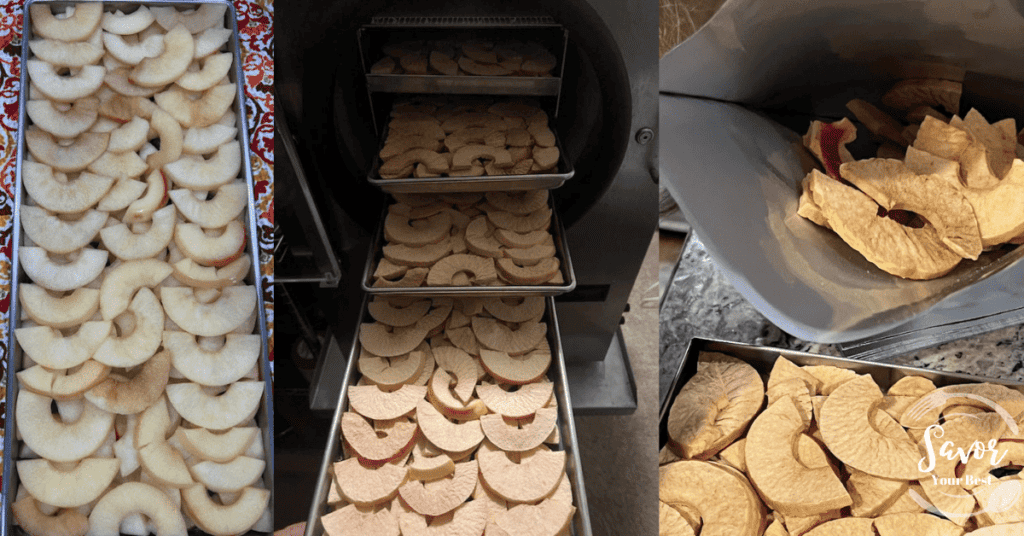
Initially, freeze drying does alter the texture of food, making it light and crispy, which is quite different from its fresh state. This crispness is often highly desired for creating snacks and treats without the need for frying or adding oils, as seen in vegetable or fruit chips. While frying, baking, or air frying fruits and vegetables can achieve a similar crispy texture, these methods require oil and can result in nutrient loss due to the cooking process. In contrast, freeze drying preserves nearly all the nutritional value of fresh fruits and vegetables, providing a crunchy snack with the simplicity of fresh produce cut into uniform shapes and freeze dried. You can also experiment by adding herbs and spices before freeze drying, achieving unique flavors without the need for fats or oils.
The true magic of freeze drying lies in its versatility. While it produces delightfully crispy snacks that make fresh foods as enjoyable as candy, these treats can easily be transformed back into their original state with just a little water and time. Imagine trying to make an apple pie using traditional apple chips—it wouldn’t work! But with freeze dried apples, you can rehydrate them back to a fresh state, making them usable in any recipe just like fresh ingredients. You can even get creative with rehydration by using liquids other than water, opening up endless possibilities limited only by your imagination.
Canning: Flavor and Texture Trade-Offs
Canning is a tried-and-true method for preserving food, but it does come with some trade-offs when it comes to flavor and texture. The canning process involves cooking food at high temperatures to kill bacteria and seal the jars. While this ensures long shelf life, it can also dull the flavors and soften the texture of your food. Vegetables might lose their crispness, even becoming mushy and fruits can become syrupy or overly sweetened if sugar is added.
For example, canned peaches might taste good but won’t have the same fresh, juicy flavor as freeze dried peaches. The texture also changes—canned peaches are softer, almost mushy, compared to the firm, bite-able texture you get with freeze dried ones.
Dehydrating: Flavor Intensity and Texture Changes
Dehydrating is another popular method for preserving food, especially for making snacks like dried fruits and jerky. However, the process of using heat to remove moisture can intensify flavors in ways that aren’t always desirable. For example, dehydrated tomatoes can taste much more concentrated, almost too intense.
Dehydrating also alters the texture of your food. Dehydrated foods often become chewy or leathery, which can be fine for certain snacks but isn’t ideal for all types of food.
The Freeze Drying Experience: A Balanced Approach
The beauty of freeze drying is that it offers a balanced approach to preserving both flavor and texture. When you freeze dry healthy food, you’re capturing the essence of that food—the taste, and the texture—and storing it in a way that keeps it as close to fresh as possible.
Whether you’re preserving fruits for snacking, vegetables for soups, or complete meals for quick, healthy dinners, freeze drying ensures that your food will taste and feel just right when you’re ready to eat it. Freeze dried foods also rehydrate well, bringing back their original texture, which is perfect for cooking meals that require fresh-like ingredients. It’s a method that respects the integrity of your ingredients, allowing you to enjoy them at their best.
Cost-Effectiveness of Freeze Drying at Home
When it comes to preserving food, cost is always a consideration. You want to get the most bang for your buck without compromising on quality. While freeze drying at home is a significant investment upfront, it can actually be a highly cost-effective method in the long run, especially when compared to other preservation methods like canning and dehydrating.
The Initial Investment: Worth Every Penny
Let’s address the elephant in the room first—the initial cost of a freeze dryer. Yes, it’s an investment, and the price tag can be intimidating. But think of it this way: a freeze dryer is like buying a premium kitchen appliance, similar to a high-quality refrigerator or oven. It’s designed to last for years and pay off in the long run by helping you freeze dry healthy food that you can enjoy for years to come.
When you consider the amount of money you might spend on store-bought freeze dried foods, the cost starts to make more sense. Commercially freeze dried foods can be quite expensive, especially if you’re buying organic or specialty items. By freeze drying at home, you can save a significant amount of money over time by preparing your own healthy, preservative-free meals and snacks. Plus, you’re in control of the ingredients, ensuring that you’re only using what you want.

Long-Term Savings on Groceries
One of the biggest benefits of freeze drying at home is the potential for long-term savings on your grocery bill. When you freeze dry healthy food, you can buy fresh produce, meats, and other ingredients in bulk when they’re in season and at their lowest prices. Instead of letting extra food go to waste, you can preserve it for later use, which means fewer trips to the grocery store and more money in your pocket.
Think about it—how often have you thrown away fruits and vegetables that went bad before you could use them? With a freeze dryer, you can preserve those foods while their still fresh, ensuring that nothing goes to waste. Over time, the savings from reducing food waste alone can help offset the initial cost of the freeze dryer. And since freeze dried foods have a long shelf life, you can stock up on essentials and be prepared for any situation, whether it’s a busy week or an unexpected event.
Comparing Operating Costs
Another aspect to consider when looking at the cost-effectiveness of freeze drying is the ongoing operating costs. Freeze dryers do use electricity; you’ll need to replace the vacuum pump oil periodically (unless you opt for an oil-less pump), but these costs are comparable to the ongoing expenses associated with other preservation methods.
Canning, for example, requires jars, lids, and sometimes even sugar or salt to preserve the food, in addition to the energy costs of boiling water for long periods. Dehydrating also uses electricity and can also take hours to complete, depending on the food and the dehydrator’s efficiency. In comparison, freeze drying is relatively efficient.
The Value of Time and Convenience
Time is money, and freeze drying offers significant time savings compared to other preservation methods. Once you’ve prepared your food and set up the freeze dryer, the machine does all the work. There’s no need to babysit the process, as you might with canning or dehydrating. This hands-off approach allows you to focus on other tasks or simply enjoy your day, knowing that your food is being preserved with minimal effort on your part.
In addition, the convenience of having freeze dried foods on hand can save you both time and money. Whether you’re prepping meals for the week, planning for a camping trip, or just looking for healthy snacks, freeze dried foods are ready when you are. This convenience means fewer last-minute grocery runs or takeout orders, which can quickly add up in terms of both time and money.
The Cost of Quality
When you freeze dry healthy food at home, you’re also investing in quality. Store-bought preserved foods often contain additives, preservatives, and excess sodium or sugar to extend shelf life. By freeze drying your own food, you can ensure that you’re eating clean, natural foods without any unwanted ingredients. This focus on quality can have long-term health benefits, potentially saving you money on healthcare costs down the line.
Plus, the superior taste and texture of freeze dried foods mean that you’re more likely to enjoy what you’ve preserved, reducing the likelihood of food waste. When your freeze dried meals and snacks taste as good as fresh, you’re more inclined to eat them, ensuring that your investment in both the freeze dryer and the food you preserve pays off.
The Clear Winner–Freeze Drying
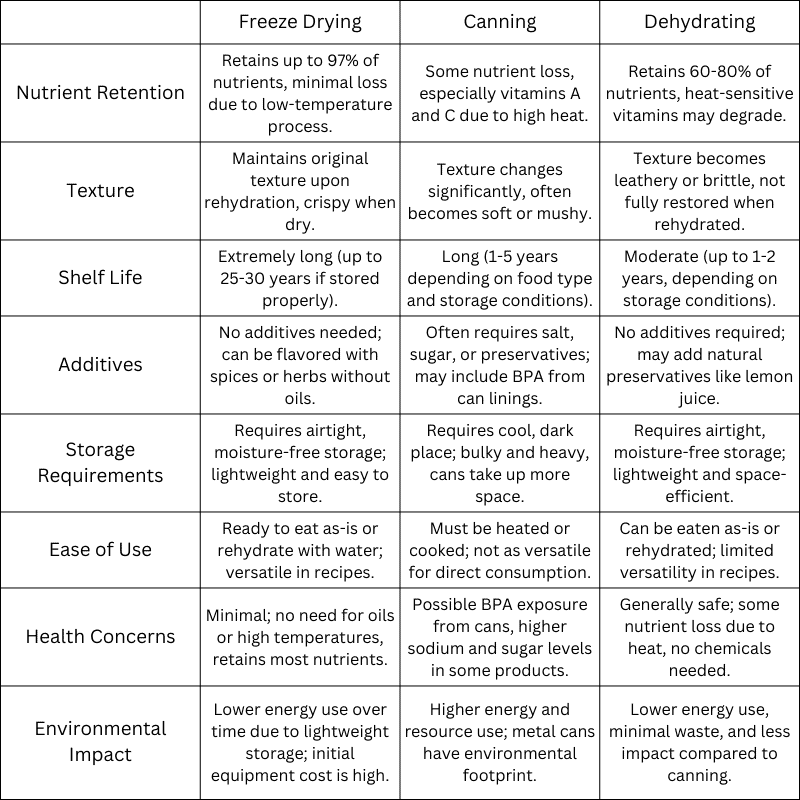
So, if you’re committed to eating well and maintaining a healthy lifestyle, consider freeze drying as your go-to method for food preservation. Not only does it help you keep your food’s nutrients intact, but it also gives you the flexibility to store a wide variety of foods for the long term. The next time you’re preparing to preserve your favorite foods, remember that when you freeze dry healthy food, you’re making a choice that supports both your wellness and your taste buds.

